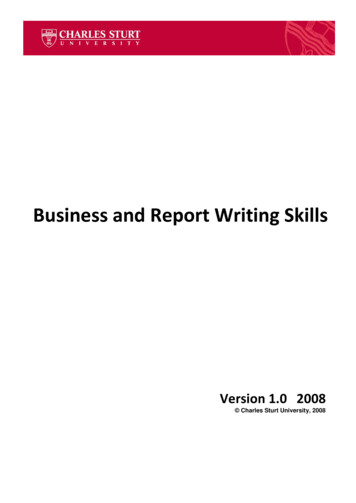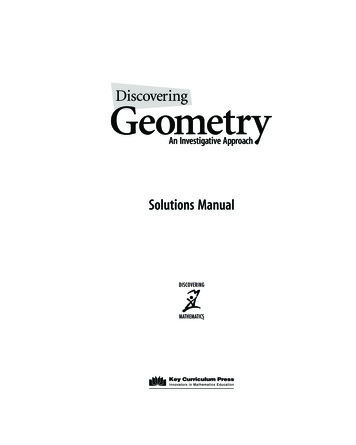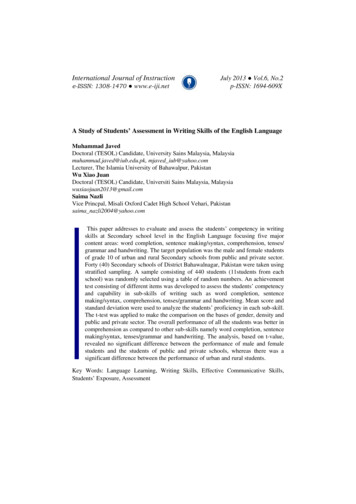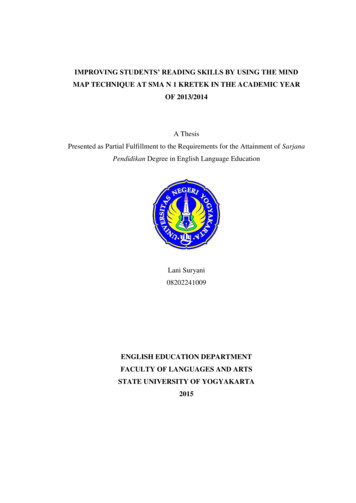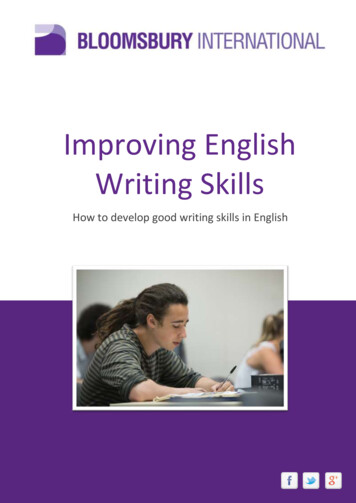
Transcription
Improving your technical writing skillsVersion 4.125 September 2003Norman FentonComputer Science DepartmentQueen Mary (University of London)London E1 4NSnorman@dcs.qmul.ac.ukwww.dcs.qmul.ac.uk/ norman/Tel: 020 7882 7860AbstractThis document describes the basic principles of good writing. It is primarily targetedat students and researchers writing technical and business reports, but the principlesare relevant to any form of writing, including letters and memos. Therefore, thedocument contains valuable lessons for anybody wishing to improve their writingskills. The ideas described here are, apart from fairly minor exceptions, not original.They are drawn from a range of excellent books and have also been influenced byvarious outstanding authors I have worked with. Thus, the approach represents a kindof modern consensus. This approach is very different to the style that was promotedby the traditional English schools’ system, which encouraged students to write in anunnecessarily complex and formal way. The approach described here emphasisessimplicity (‘plain English’) and informality. For example, it encourages shortersentences and use of the simplest words and phrases possible. It explains how you canachieve simplicity by using the active rather than the passive style, personal ratherthan impersonal style, and by avoiding noun constructs in favour of verbs. Crucially,this approach leads to better reports because they are much easier to read andunderstand.
Fenton: Improving your technical writingVersion 4.1Document change historyVersion 1.0, 11 September 2000: Derived from Norman Fenton’s ‘Good Writing’ web pages.Version 2.0, 21 September 2001. Minor changes including addition of student projectguidelines.Version 2.1, 20 September 2002. Minor corrections made.Version 3.0, 14 September 2003. Major revision.Version 4.0, 23 September 2003. Restructuring and editing.Version 4.1, 25 September 2003. Various typos fixed and polemic removed.23 September 2003Page 2/33
Fenton: Improving your technical writingVersion 4.1Table of contents1.INTRODUCTION .42.BEFORE YOU START WRITING .53.USING PLAIN ENGLISH: STYLE.63.1SENTENCE AND PARAGRAPH LENGTH .63.2BULLET POINTS AND ENUMERATED LISTS .73.3USING THE SIMPLEST WORDS AND EXPRESSIONS POSSIBLE .83.3.1Replace difficult words and phrases with simpler alternatives .93.3.2Avoid stock phrases .93.3.3Avoid legal words and pomposity.103.3.4Avoid jargon .103.4AVOIDING UNNECESSARY WORDS AND REPETITION.103.5USING VERBS INSTEAD OF NOUNS .123.6USING ACTIVE RATHER THAN PASSIVE STYLE .133.7USING PERSONAL RATHER THAN IMPERSONAL STYLE.133.8EXPLAIN NEW IDEAS CLEARLY .153.9USE CONSISTENT NAMING OF THE SAME ‘THINGS’.153.10 PAINLESS POLITICAL CORRECTNESS .163.11 SUMMARY .174.USING PLAIN ENGLISH: THE MECHANICS .184.1AVOIDING COMMON VOCABULARY AND SPELLING ERRORS.184.2ABBREVIATIONS .194.3PUNCTUATION .194.3.1Capital letters .204.3.2Apostrophes .204.3.3Commas .214.3.4Exclamation marks .214.4SUMMARY .225.BASIC STRUCTURE FOR REPORTS .235.15.25.35.45.55.65.7WHAT EVERY REPORT SHOULD CONTAIN.23GENERAL LAYOUT .24SECTIONS AND SECTION NUMBERING .24THE CRUCIAL ROLE OF ‘INTRODUCTIONS’ AND SUMMARIES .25FIGURES AND TABLES .26A STRUCTURE FOR STUDENT PROJECT REPORTS .27SUMMARY AND CHECKLIST FOR WHEN YOU FINISH WRITING .286.ABSTRACTS AND EXECUTIVE SUMMARIES .297.WRITING THAT INCLUDES MATHEMATICS.318.SUMMARY AND CONCLUSIONS .329.REFERENCES .3323 September 2003Page 3/33
Fenton: Improving your technical writingVersion 4.11. IntroductionCompare the following two sentences that provide instructions to a set of employees (thisExample is given in [Roy 2000]):1. It is of considerable importance to ensure that under no circumstances shouldanyone fail to deactivate the overhead luminescent function at its local activationpoint on their departure to their place of residence, most notably immediatelypreceding the two day period at the termination of the standard working week.2. Always turn the lights out when you go home, especially on a Friday.The meaning of both sentences is, of course, equivalent. Which one was easier to read andunderstand? The objective of this document is to show people how to write as in the secondsentence rather than the first. If you actually prefer the first, then there is little point in youreading the rest of this document. But please do not expect to win too many friends (or marks)from any writing that you produce.Unfortunately, the great shame for anybody having to read lots of reports in their everydaylife is that the schools’ system continues to produce students who feel they ought to writemore like in the first sentence than the second. Hence, the unnecessarily complex and formalstyle is still common. This document shows you that there is a better way to write, usingsimple, plain English.One of the good things about technical writing is that you really can learn to improve. Youshould not believe people who say that being a good writer is a natural ability that you eitherhave or do not have. We are talking here about presenting technical or business reports andnot about writing novels. I speak from some experience in this respect, because in the last tenyears I have learned these ideas and applied them to become a better writer. When I waswriting my first book in 1989 an outstanding technical editor highlighted the many problemswith my writing. I was guilty of many of the examples of bad practice that I will highlightthroughout this document. You too can improve your writing significantly if you are aware ofwhat these bad practices are and how to avoid them.The document contains the following main sections: Before you start writing (Section 2): This is a simple checklist that stresses theimportance of knowing your objective and audience. Using plain English: style (Section 3). This is the heart of the document because itexplains how to write in the simplest and most effective way. Using plain English: the mechanics (Section 4). This covers vocabulary, spelling, andpunctuation. Basic structure for reports (Section 5). This section explains how to organise yourreport into sections and how to lay it out. Abstracts and executive summaries (Section 6). This explains the difference betweeninformative and descriptive abstracts. It tells you why you should always useinformative abstracts and how to write them. Writing that includes mathematics (Section 7). This contains some simple rules youshould follow if your writing includes mathematical symbols or formulas.23 September 2003Page 4/33
Fenton: Improving your technical writingVersion 4.12. Before you start writingBefore you start producing your word-processed report you must make sure you do thefollowing: Decide what the objective of the report is. This is critical. If you fail to do this you willalmost certainly produce something that is unsatisfactory. Every report should have asingle clear objective. Make the objective as specific as possible. Write down the objective. Ideally, this should be in one sentence. For example, theobjective of this document is “to help students write well structured, easy-to-understandtechnical reports”. The objective should then be stated at the beginning of the report. Ifyou cannot write down the objective in one sentence, then you are not yet ready to startany writing. Always have in mind a specific reader. You should assume that the reader is intelligentbut uninformed. It may be useful to state up front what the reader profile is. For example,the target readers for this document are primarily students and researchers with a goodworking knowledge of English. The document is not suitable for children under 13, orpeople who have yet to write documents in English. It is ideal for people who havewritten technical or business documents and wish to improve their writing skills. Decide what information you need to include. You should use the objective as yourreference and list the areas you need to cover. Once you have collected the informationmake a note of each main point and then sort them into logical groups. Ultimately youhave to make sure that every sentence makes a contribution to the objective. If materialyou write does not make a contribution to the objective remove it – if it is good you mayeven be able to reuse it in a different report with a different objective. Have access to a good dictionary. Before using a word that ‘sounds good’, but whosemeaning you are not sure of, check it in the dictionary. Do the same for any word you arenot sure how to spell. Identify someone who can provide feedback. Make sure you identify a friend, relative orcolleague who can read at least one draft of your report before you submit it formally. Donot worry if the person does not understand the technical area – they can at least checkthe structure and style and it may even force you to write in the plain English styleadvocated here.The following checklist should be applied before you give even an early draft of yourdocument out for review: Check that the structure conforms to all the rules described in this document. Run the document through a spelling checker. Read it through carefully, trying to put yourself in the shoes of your potential readers.23 September 2003Page 5/33
Fenton: Improving your technical writingVersion 4.13. Using plain English: styleWhen you are producing a technical or business report you want it to ‘get results’. If you are astudent this can mean literally getting a good grade. More generally we mean that you want toconvince the reader that what you have to say is sensible so that they act accordingly. If thereport is a proposal then you want the reader to accept your recommendations. If the reportdescribes a piece of research then you want the reader to understand what you did and why itwas important and valid. Trying to be ‘clever’ and ‘cryptic’ in the way you write will confuseand annoy your readers and have the opposite effect to what you wanted. In all cases you aremore likely to get results if you present your ideas and information in the simplest possibleway. This section describes how to do this.The section is structured as follows: Sections 3.1 and 3.2 describe structural techniques for making your writing easier tounderstand. Specifically:oSentence and paragraph length: keeping them short is the simplest first step toimproved writing.oBullet points and lists: using these makes things clearer and less cluttered.Sections 3.3 and 3.4 describe techniques for using fewer words. Specifically:oUsing the simplest words and expressions available: this section also describes wordsand expressions to avoid.oAvoiding unnecessary words: this is about removing redundancy.Sections 3.5 to 3.7 describe techniques for avoiding common causes of poorly structuredsentences. Specifically:oUsing verbs instead of nounsoUsing active rather than passive styleoUsing personal rather than impersonal style Section 3.8 describes how to explain new ideas clearly. Section 3.9 explains the importance of naming things consistently. Section 3.10 gives some rules on how to achieve political correctness in your writingwithout adding complexity.3.1 Sentence and paragraph lengthContrary to what you may have learnt in school, there is nothing clever about writing long,complex sentences. For technical writing it is simply wrong. You must get used to the idea ofwriting sentences that are reasonably short and simple. In many cases shorter sentences can beachieved by sticking to the following principles:1. A sentence should contain a single unit of information. Therefore, avoid compoundsentences wherever possible. In particular, be on the lookout for words like and, orand while which are often used unnecessarily to build a compound sentence.23 September 2003Page 6/33
Fenton: Improving your technical writingVersion 4.12. Check your sentences for faulty construction. Incorrect use of commas (see Section4.3 for how to use commas correctly) is a common cause of poorly constructed andexcessively long sentences.Example (this example fixes some other problems also that are dealt with below)Bad: “Time division multiplexed systems are basically much simpler, thecombination and separation of channels being affected by timing circuitsrather than by filters and inter-channel interference is less dependent onsystem non-linearities, due to the fact that only one channel is using thecommon communication medium at any instant.”Good: “Systems multiplexed by time division are basically much simpler.The channels are combined and separated by timing circuits, not byfilters. Interference between channels depends less on non-linear featuresof the system, because only one channel is using the commoncommunication medium at any time.”3. Use parentheses sparingly. Most uses are due to laziness and can be avoided bybreaking up the sentence. Never use nested parentheses if you want to retain yourreader.Learning about some of the principles described below, especially using active rather thanpassive constructs, will go a long way toward helping you shorten your sentences.Just as it is bad to write long sentences it is also bad to write long paragraphs. A paragraphshould contain a single coherent idea. You should always keep paragraphs to less than half apage. On the other hand, successive paragraphs that are very short may also be difficult toread. Such an approach is often the result of poorly structured thinking. If you need to write asequence of sentences that each express a different idea then it is usually best to use bulletpoints or enumerated lists to do so. We consider these next.3.2 Bullet points and enumerated listsIf the sentences in a paragraph need to be written in sequence then this suggests that there issomething that relates them and that they form some kind of a list. The idea that relates themshould be used to introduce the list. For example, the following paragraph is a mess becausethe writer is trying to make what is clearly a list into one paragraph:Getting to university on time for a 9.00am lecture involves following a number ofsteps. First of all you have to set your alarm – you will need to do this before you goto bed the previous night. When the alarm goes off you will need to get out of bed.You should next take a shower and then get yourself dressed. After getting dressedyou should have some breakfast. After breakfast you have to walk to the tube station,and then buy a ticket when you get there. Once you have your ticket you can catchthe next train to Stepney Green. When the train arrives at Stepney Green you shouldget off and then finally walk to the University.The following is much simpler and clearer:To get to university on time for a 9.00am lecture:1.2.3.4.5.Set alarm before going to bed the previous nightGet out of bed when the alarm goes offTake a showerGet dressedHave some breakfast23 September 2003Page 7/33
Fenton: Improving your technical writing6.7.8.9.10.Version 4.1Walk to the tube stationBuy ticketCatch next train to Stepney GreenGet out at Stepney GreenWalk to the UniversityThe simple rule of thumb is: if what you are describing is a list then you should alwaysdisplay it as a list.The above is an example of an enumerated list. The items need to be shown in numberedorder. If there is no specific ordering of the items in the list then you should use bullet pointsinstead. For example consider the following paragraph:Good software engineering is based on a number of key principles. One suchprinciple is getting a good understanding of the customer requirements (possibly byprototyping). It is also important to deliver in regular increments, involving thecustomer/user as much as possible. Another principle it that it is necessary to dotesting throughout, with unit testing being especially crucial. In addition to theprevious principles, you need to be able to maintain good communication within theproject team (and also with the customer).The paragraph is much better when rewritten using bullet points:Good software engineering is based on the following key principles: Get a good understanding of the customer requirements (possibly byprototyping).Deliver in regular increments (involve the customer/user as much aspossible).Do testing throughout, (unit testing is especially crucial).Maintain good communication within the project team (and also with thecustomer).There are numerous examples throughout this report of bullet points and enumerated lists.You should never be sparing in your use of such lists. Also, note the following rule forpunctuation in lists:If all the list items are very short, by which we normally mean less than one line long,then there is no need for any punctuation. Otherwise use a full stop at the end of eachlist item.3.3 Using the simplest words and expressions possibleOn a recent trip to Brussels by Eurostar the train manager made the followingannouncement: “Do not hesitate to contact us in the event that you are in need ifassistance at this time”. What she meant was: “Please contact us if you need help now”,but she clearly did not use the simplest words and expressions possible. While this maybe acceptable verbally, it is not acceptable in writing.The golden rules on words and expressions to avoid are: Replace difficult words and phrases with simpler alternatives; Avoid stock phrases; Avoid legal words and pomposity; Avoid jargon.We will deal with each of these in turn.23 September 2003Page 8/33
Fenton: Improving your technical writingVersion 4.13.3.1 Replace difficult words and phrases with simpler alternativesTable 1 lists a number of words and expressions that should generally be avoided in favour ofthe simple alternative.Table 1 Words and expressions to avoidWord/expression toavoidutilisefacilitateat this timein respect ofcommenceterminateascertainin the event ofin startend, stopfind outifsoaskWord/expression teassist, assistancenecessitatein excess ofdwellingSimplealternativetryend, stopsendshowbeginhelpneedmore thanhouseAlso, unless you are talking about building maintenance or computer graphics, never use theverb ‘render’ as in:The testing strategy rendered it impossible to find all the faults.The ‘correct’ version of the above sentence is:The testing strategy made it impossible to find all the faults.In other words, if you mean ‘make’ then just write ‘make’ not ‘render’.3.3.2 Avoid stock phrasesStock phrase like those shown in Table 2 should be avoided in favour of the simpleralternative. Such phrases are cumbersome and pompous.Table 2 Stock phrases to avoidBADThere is a reasonable expectation that .Owing to the situation that Should a situation arise where Taking into consideration such factors as Prior to the occasion when At this precise moment in time Do not hesitate to I am in receipt of 23 September 2003GOODProbably Because, since If Considering Before Now Please I have Page 9/33
Fenton: Improving your technical writingVersion 4.13.3.3 Avoid legal words and pomposityLawyers seem to have a language of their own. This is primarily to ensure that theirdocuments are so difficult to understand that only other lawyers can read them. This ensuresmore work and money for lawyers because it forces ordinary people to pay lawyers for workthey could do themselves. For some strange reason ordinary people often think they are beingvery clever by using legal words and expressions in their own writing. Do not fall into thistrap. Avoid legal words like the ewithOf the (4th) inst.thereatthereinthereofwhereatwhereonAlso avoid nonsensical legal references like the following:“The said software compiler ”which should be changed to“The software compiler ”and:“The aforementioned people have agreed ”which should be changed to“A and B have agreed ”3.3.4 Avoid jargonExpressions like MS/DOS, Poisson distribution, and distributor cap are examples of jargon.In general, jargon refers to descriptions of specific things within a specialised field. Thedescriptions are often shorthand or abbreviations. If you are certain that every reader of yourreport understands the specialist field then it can be acceptable to use jargon. For example, ifyour only potential readers are computer specialists then it is probably OK to refer toMS/DOS without the need to explain what MS/DOS is or stands for. The same applies toPoisson distribution if your readers are all statisticians or distributor cap if your readers arecar mechanics. In all other cases (which is almost always) jargon should be avoided. If youcannot avoid it by using alternative expressions then you should define the term the first timeyou use it and/or provide a glossary where it is defined.3.4 Avoiding unnecessary words and repetitionMany sentences contain unnecessary words that repeat an idea already expressed in anotherword. This wastes space and blunts the message. In many cases unnecessary words are causedby ‘abstract’ words like nature, position, character, condition and situation as the followingexamples show:23 September 2003Page 10/33
Fenton: Improving your technical writingVersion 4.1BADThe product is not of a satisfactory natureThe product is not of a satisfactory characterAfter specification we are in a position tobegin detailed designWe are now in the situation of being able tobegin detailed designGOODThe product is unsatisfactoryThe product is unsatisfactoryAfter specification we can begin detaileddesignWe can now begin detailed designIn general, you should therefore use such abstract words sparingly, if at all.Often writers use several words for ideas that can be expressed in one. This leads tounnecessarily complex sentences and genuine redundancy as the following examples show:WITH REDUNDANCYThe printer is located adjacent to thecomputerThe printer is located in the immediatevicinity of the computerThe user can visibly see the image movingHe wore a shirt that was blue in colourThe input is suitably processedThis is done by means of inserting anartificial faultThe reason for the increase in number offaults found was due to an increase intestingIt is likely that problems will arise withregards to the completion of thespecification phaseWithin a comparatively short period we willbe able to finish the designWITHOUT REDUNDANCYThe printer is adjacent to the computerThe printer is near the computerThe user can see the image movingHe wore a blue shirtThe input is processedThis is done by inserting an artificial faultThe increase in number of faults found wasdue to an increase in testingYou will probably have problemscompleting the specification phaseSoon we will be able to finish the designAnother common cause of redundant words is when people use so-called modifying words.For example, the word suitable in the sentence “John left the building in suitable haste” is amodifying word. It is redundant because the sentence “John left the building in haste” hasexactly the same meaning. Similarly, the other form of a modifying word – the one ending in‘y’ as in suitably – is also usually redundant. For example, “John was suitably impressed”says nothing more than “John was impressed”. Other examples are:BADabsolute nonsenseabsolutely criticalconsiderable difficultyconsiderably difficult23 September 2003GOODnonsensecriticaldifficultydifficultPage 11/33
Fenton: Improving your technical writingVersion 4.1Modifying words can be fine when used with a concrete reference, as in the example “Jane setJohn a suitable task” but in many cases they are not and so are best avoided: Here are themost common modifying words to cientsuitableundueutterFinally, one of the simplest ways to shorten and simplify your reports is to remove repetition.Poorly structured reports are often characterised by the same idea being described in differentplaces. The only ‘allowable’ repetition is in introductions and summaries, as we shall see inSection 5.4. You can avoid repetition by checking through your report and jotting down a listof the key ideas as they appear. Where the same idea appears more than once, you have todecide once and for all the place where it should best go and then delete and/or merge the textaccordingly.3.5 Using verbs instead of nounsLook at the following sentence:“Half the team were involved in the development of system Y”.This sentence contains a classic example of a common cause of poor writing style. Thesentence is using an abstract noun ‘development’ instead of the verb ‘develop’ from which itis derived. The simpler and more natural version of the sentence is:“Half the team were involved in developing system Y”.Turning verbs into abstract nouns always results in longer sentences than necessary, so youshould avoid doing it. The following examples show the improvements you can achieve bygetting rid of nouns in favour of verbs:BADHe used to help in the specification of newsoftwareAcid rain accounts for the destruction of ancientstone-workWhen you take into consideration Clicking the icon causes the execution of theprogramMeasurement of static software properties wasperformed by the toolThe analysis of the software was performed byFredThe testing of the software was carried out by JaneIt was reported by Jones that method x facilitatedthe utilisation of inspection techniques by thetesting team23 September 2003GOODHe used to help specify new softwareAcid rain destroys ancient stone-workWhen you consider The program executes when the icon isclickedThe tool measured static softwarepropertiesFred analysed the softwareJane tested the softwareJones reported that method x helped thetesting team use inspection techniquesPage 12/33
Fenton: Improving your technical writingVersion 4.1The last example is a particular favourite of mine (the bad version appeared in a publishedpaper) since it manages to breach just about every principle of good writing style. It uses anoun construct instead of a verb and it includes two of the forbidden words (facilitated,utilisation). However, one of the worst features of this sentence is that it says “It was reportedby Jones” instead of simply “Jones reported”. This is a classic example of use of passiverather active constructs. We deal with this in the next section.3.6 Using active rather than passive styleConsider the following two sentences:1. Joe tested the software2. The softwar
This document describes the basic principles of good writing. It is primarily targeted at students and researchers writing technical and business reports, but the principles are relevant to any form of writing, including letters and memos. Therefore, the document contains valuable lessons for anybody

